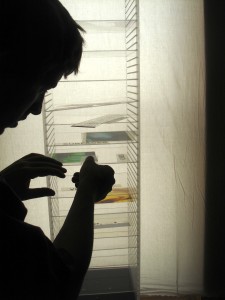History Whistle is the first video I created using the video printmaking technique wherin a performer slides class plates containing parts of the whole image in front of a video camera.
The viewer watches the image being created and disected as the camera jumps focus from layer to layer.
History Whistle was originaly a painting that I made for Ralph Barton for Easter. I chose to translate that one because I had scanned it before giving it to him because he thought that it would make a good video layer.
The sound is by Chicago IDM group Heavy Petting
Video-Printmaking
I refer to this process as video-printmaking because it incorporates the multiple plates often necessary to create a complex printed image and the dimension of duration, intrinsic to the video medium.
Many printmaking techniques involve the use of several individual plates, often one for each different color. When these plates are each inked and their individual parts are brought together on the paper, you see the completed image. In video printmaking, the different layers function a bit differently. Instead of each plate offering a different color, each layer offers a different layer of focus. As the camera’s auto-focus jumps from layer to layer, the viewer sees each layer for a moment and their mind completes the image.
 How it Works
How it Works
In order to create the focus shifting effect, two things are necessary. First, it is necessary for the plates to be at different distances from the camera. Second, a strobe is necessary to trigger the cameras focus jump. I designed several different versions of an apparatus that would accomplish this. The first was little more than a CD rack and television with bad vertical hold. The plates were CD JEWEL cases with parts of the image printed on transparency. The TV’s scrolling vertical lines created a throbbing light that made the camera reconsider which layer to focus on, and did so to a consistent beat. By adjusting the V-hold knob on the TV I could reset the speed of the throb and therefore the tempo of the video. I have since fabricated a 5 foot wooden version and have assisted in the creation of a clear three-foot table top model made from plexi-glass.
History Whistle and Beyond
The first video I created using the video-printmaking technique was titled History Whistle. The image was dissected into many layers. When brought together, it resembled a dial or clock. It was originally a painting that I made for Ralph Barton for Easter. I chose to translate that one because he had made the strange statement that it would make a really great video. I decided to take the challenge. I have since made several videos using this strategy and the throbbing focus shift has become a trademark style of Rook-TV (see ROOK-TV). I have also taught this process to several other artists and have seen it utilized in both high-art and commercial applications.
